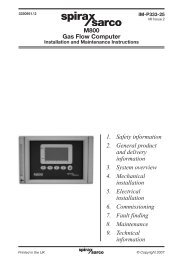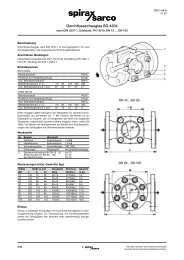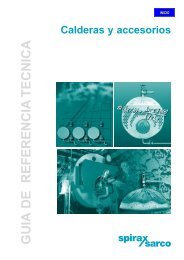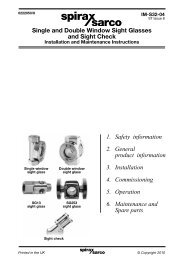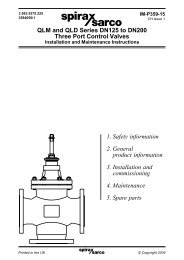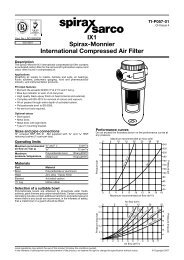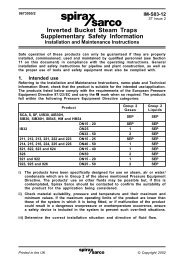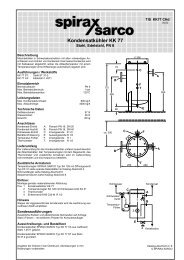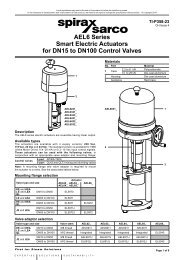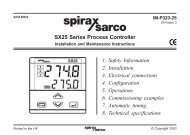2000 Hook-up Book - Spirax Sarco
2000 Hook-up Book - Spirax Sarco
2000 Hook-up Book - Spirax Sarco
You also want an ePaper? Increase the reach of your titles
YUMPU automatically turns print PDFs into web optimized ePapers that Google loves.
SYSTEM DESIGN<br />
32<br />
Make<strong>up</strong> Air Heating Coils<br />
The steam trap must handle<br />
lots of air and drain condensate<br />
at saturated steam temperature<br />
continuously while the load and<br />
pressure are changing and thus a<br />
Float-Thermostatic type is recommended<br />
for all air heating coils.<br />
The trap is mounted below the<br />
condensate outlet from the coil<br />
with a vertical drop giving enough<br />
hydraulic head to enable a suitable<br />
size to be selected. A 14"<br />
head should be the minimum and<br />
represents about 1/2 psi, a 28"<br />
head about 1 psi, and to reduce<br />
possibility of freeze-<strong>up</strong>, a drop of<br />
3 ft. to the trap is recommended.<br />
Preheat/Reheat Coils<br />
The preheat/reheat coil hook<strong>up</strong><br />
shown in Fig. II-26 (page 96) may<br />
employ a direct-acting temperature<br />
control or with larger coils, a quicker<br />
responding pilot-operated type<br />
with a closer control band is recommended.<br />
This arrangement<br />
allows filtration and perhaps humidification<br />
of the air to be carried out<br />
at the controlled preheat temperature,<br />
and the reheat coil brings the<br />
dry bulb temperature of the conditioned<br />
air to the required value for<br />
distribution. The preheat coil is<br />
used to heat outside air <strong>up</strong> to the<br />
intermediate temperature but as<br />
outside temperature increases, the<br />
temperature control lowers the<br />
steam pressure in the preheat coil<br />
and condensate drainage tends to<br />
slow down. If the coil is being used<br />
where design loads occur at subzero<br />
temperatures, there can<br />
sometimes be only atmospheric<br />
pressure in the coil, although the air<br />
passing over it is still cold enough<br />
to lead to freeze-<strong>up</strong> problems.<br />
This difficulty is greatly<br />
reduced if the temperature sensor<br />
controlling the steam s<strong>up</strong>ply to the<br />
preheat coil is set to the needed<br />
distribution temperature. Part load<br />
conditions would then lead firstly to<br />
lowering the steam pressure in the<br />
reheat coil, where freezing will not<br />
occur, but pressure is maintained<br />
in the preheat coil until outside air<br />
temperatures are above the danger<br />
point. Such an arrangement<br />
reduces freeze-<strong>up</strong> problems in<br />
many instances on existing installations,<br />
at minimal cost.<br />
Corrosion And Waterhammer<br />
Problems<br />
Condensate mixed with air<br />
becomes corrosive and assuming<br />
the boiler water treatment is satis-<br />
Case in Action: Air Handling System Steam Coil Drainage<br />
Typical storage buildings are extremely large and difficult to<br />
heat. This example in specific has three floors with approximately<br />
486,000 ft 2 of floor space and heated with 150 air<br />
handling units. These units are comprised of bay heaters,<br />
overhead door heaters and administrative office area<br />
heaters. The minimum steam s<strong>up</strong>ply pressure to all of them<br />
is 20 psig and are pneumatically controlled.<br />
In the preceding 12 month period, $201,000 was<br />
spent on labor and materials to repair damaged coils. The<br />
common problem was condensate standing in the coils,<br />
unable to drain, causing erosion due to presence of carbonic<br />
acid and bulging/splitting as a result of freezing.<br />
Solution<br />
Starting with a training session at the facility that addressed<br />
this problem and typical solutions, <strong>Spirax</strong> <strong>Sarco</strong>’s local<br />
sales office implemented a “Cooperative Research and<br />
Development Agreement” (CRDA). The purpose of the<br />
agreement was to test a proposed solution including<br />
Pressure Powered Pumps and Pump/Trap combinations<br />
to eliminate system stall, thereby assuring thorough condensate<br />
drainage, regardless of s<strong>up</strong>ply air temperature,<br />
control valve turn-down or over-sized heaters.<br />
A test was conducted on four air handling units. One<br />
unit was hooked <strong>up</strong> as usual, without Pressure Powered<br />
factory, coil corrosion problems<br />
are usually due to condensate<br />
regularly backing <strong>up</strong> or lying stagnant<br />
on the bottom of the tubes<br />
during shutdown. If the coil is<br />
trapped correctly, the most likely<br />
cause is an overhead return<br />
which prevents the coil from draining.<br />
One remedy for this is to fit a<br />
liquid expansion steam trap at the<br />
lowest piping level, as shown in<br />
Fig. II-26 (page 96), set to open<br />
when the temperature drops<br />
below 90°F. The coil then drains<br />
only cold condensate to a sewer.<br />
In high pressure systems<br />
where waterhammer on start<strong>up</strong><br />
remains troublesome, a “safety<br />
drain” trap is sometimes used. This<br />
consists of a stock 15 psi rated<br />
inverted bucket trap fitted above<br />
the main trap which discharges to<br />
drain whenever coil pressure is<br />
low, but due to its design locks shut<br />
at higher pressure. While this is<br />
useful on pressurized mains, the<br />
safety trap may require a pressure<br />
considerably higher than its nominal<br />
rating to lock shut and on<br />
modulating service a considerable<br />
amount of condensate may be<br />
wasted. This makes the combination<br />
pump/trap a more viable<br />
solution to this problem.<br />
Pump drainage systems. The other three were drained<br />
by either open or closed loop PPP systems. Four days into<br />
the test and the unit without a PPP drainage system had<br />
three frozen coils. It was found that as outside s<strong>up</strong>ply air<br />
temperature dropped below 36˚F, it was necessary to close<br />
outside dampers and use 100% recirculated air, or the<br />
coils would freeze. The three units drained by PPP systems<br />
continued operating trouble-free.<br />
Benefits<br />
Employee Safety<br />
• Improved indoor air quality through the use of a higher<br />
percentage of outside air s<strong>up</strong>ply.<br />
• Reduced chance of injury by eliminating water leakage on<br />
the floor from broken coils and subsequent slippage.<br />
• Fewer burns because there are fewer steam leaks.<br />
• Greater employee awareness of hazards because of<br />
training.<br />
Cost Savings<br />
• Reduced steam and condensate losses resulting in<br />
energy savings.<br />
• Reduced cost for management s<strong>up</strong>port (paper-work).<br />
• Cost savings of <strong>up</strong> to 30% above the initial installation<br />
cost in a 12 month period.



